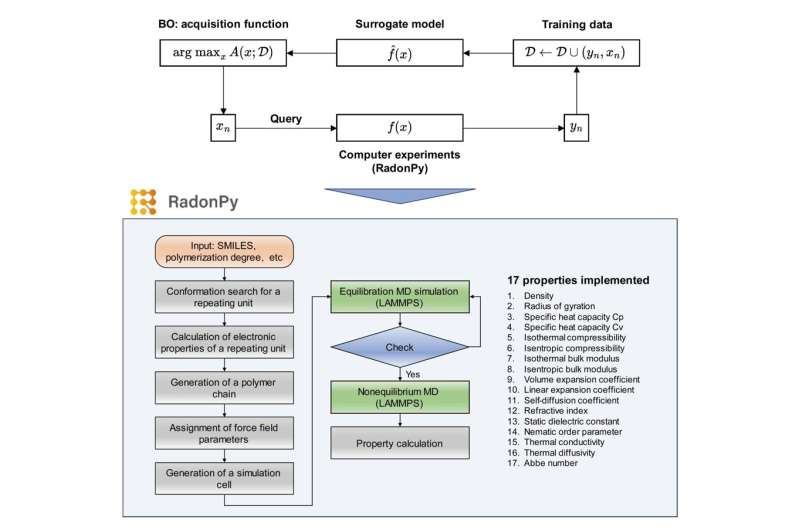A research group has developed SPACIER, an advanced polymer material design tool that integrates machine learning with molecular simulations. As a proof of concept, the group successfully synthesized new optical polymers that exceed the empirical limits of refractive index and Abbe number. The research was published in npj Computational Materials on 28 January 2025.
Machine learning has rapidly advanced the design and discovery of new materials across various systems. To overcome the challenge of limited experimental data and the limitations of interpolative machine learning predictors, first-principles calculations and other computational experiments have been incorporated into material design pipelines.
However, the enormous computational costs and technical difficulties of automating computer experiments for polymeric materials have hindered the development of open-source tools combining molecular simulations with machine learning for polymer design.
To tackle these challenges, a research group comprising Shun Nanjo, a graduate student at The Graduate University for Advanced Studies (SOKENDAI), Arifin, a researcher at JSR Corporation, Professor Teruaki Hayakawa from Institute of Science Tokyo, and Professor Ryo Yoshida from The Institute of Statistical Mathematics (ISM) has been developing RadonPy, a Python library designed to automate computational experiments, such as all-atom molecular dynamics simulations, for a wide range of polymer materials systems.
Building on this foundation, the group created SPACIER, an open-source software that integrates RadonPy with polymer design algorithms based on Bayesian optimization.
Using the multi-objective optimization framework implemented in SPACIER, the team designed optical polymers that surpass the Pareto boundary formed by the tradeoff between refractive index and Abbe number. These polymers were successfully synthesized, demonstrating the tool’s practical potential.
A major challenge in data-driven materials research lies in the scarcity of data resources. Obtaining sufficient data for machine learning applications is often difficult. This challenge is particularly pronounced for polymeric materials.
In this area, computer experiments have been integrated into machine-learning pipelines to overcome the quantitative constraints of experimental data and the limitations of interpolative machine-learning predictions.
Various machine learning algorithms have been developed for inorganic solid-state materials and small molecules. However, research on polymeric materials has been hindered owing to technical barriers in automating and accelerating all-atom molecular simulations.

The research group developed the autonomous polymer design tool, SPACIER (materials SPAce frontier), which integrates fully automated polymer physical property calculations based on all-atom classical molecular dynamics (MD) simulations into a BO-accelerated material design pipeline.
RadonPy is open-source software developed by the research group at ISM, which can fully automate polymer physical property calculations using MD simulations.
Given a polymer repeat unit, degree of polymerization, and other calculation conditions, the entire MD simulation process is fully automated, including conformational search, charge calculation, force field parameter assignment, polymer chain generation, equilibrium and nonequilibrium calculations, and physical property calculations.
The latest version of RadonPy supports automatic calculation of 17 different properties, including thermal, optical, and mechanical properties. SPACIER builds on RadonPy’s functionalities, incorporating adaptive experimental design algorithms to enable efficient and strategic polymer material design. This tool is expected to significantly accelerate the exploration and optimization of polymer material properties.
As a proof-of-concept study, the research group applied SPACIER to discover optical polymers, which are materials used in products like eyeglasses and camera lenses. The key requirements for optical polymers are high refractive index and high Abbe number.
The Abbe number is a physical property that describes the color dispersion of a transparent material. However, there is an empirically known “limiting boundary” between the refractive index and Abbe number, formed by their trade-off relationship.
In this study, SPACIER conducted systematic computer experiments to explore polymers that exceed the empirical limit. As a result, newly synthesized polymers were experimentally confirmed to surpass the previously known boundary, demonstrating the effectiveness of the tool in advancing polymer material design.
In this manner, SPACIER is capable of reaching any region in the chemical space as long as the target polymer systems are computable in or calibratable from RadonPy.
Currently, the research group at ISM is advancing the further development of RadonPy through an industry-academia consortium comprising two national research institutes, eight universities, and 37 companies. This initiative will further accelerate the development of data-driven polymer materials research.
More information:
Shun Nanjo et al, SPACIER: on-demand polymer design with fully automated all-atom classical molecular dynamics integrated into machine learning pipelines, npj Computational Materials (2025). DOI: 10.1038/s41524-024-01492-3
Provided by
Research Organization of Information and Systems
Citation:
Automated polymer design tool integrates machine learning and molecular simulations (2025, February 5)
retrieved 5 February 2025
from https://phys.org/news/2025-02-automated-polymer-tool-machine-molecular.html
This document is subject to copyright. Apart from any fair dealing for the purpose of private study or research, no
part may be reproduced without the written permission. The content is provided for information purposes only.

